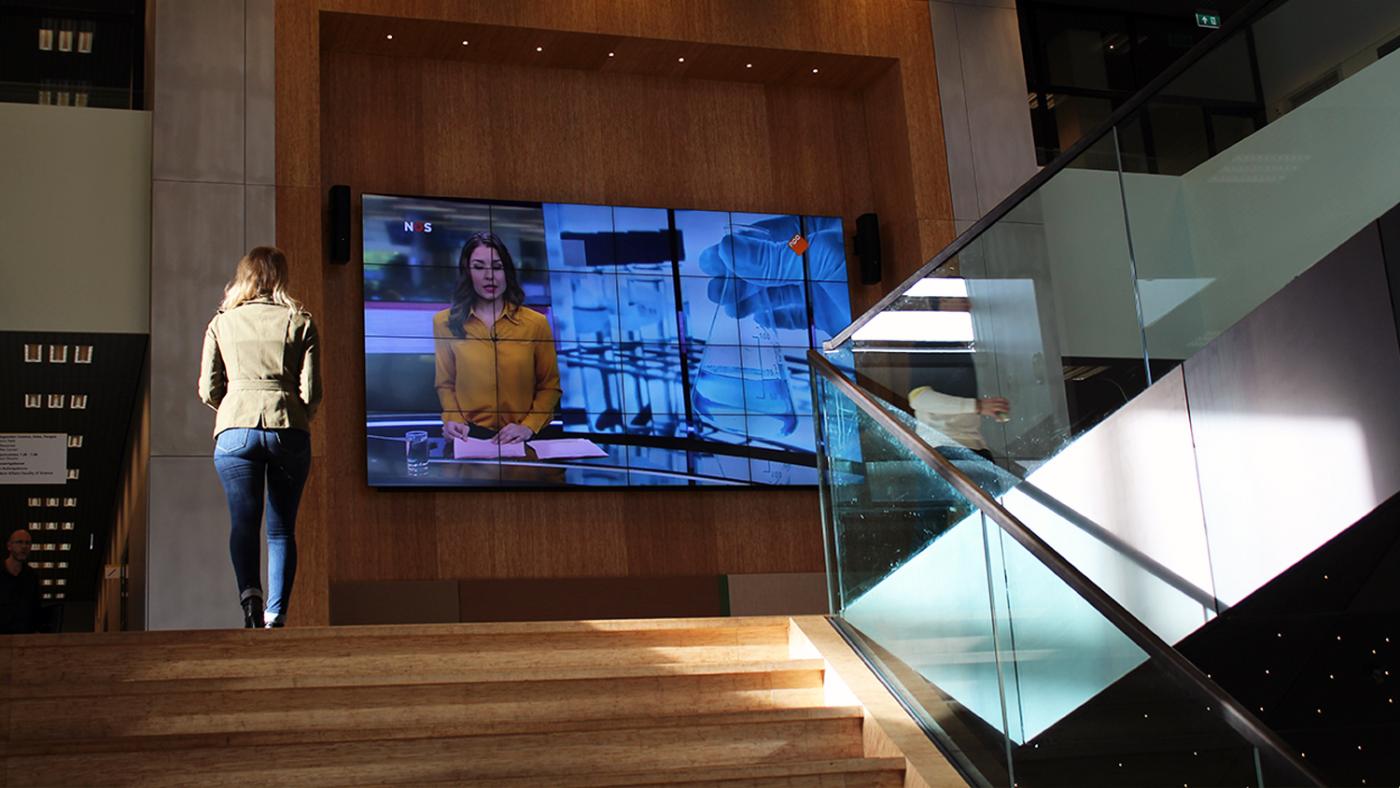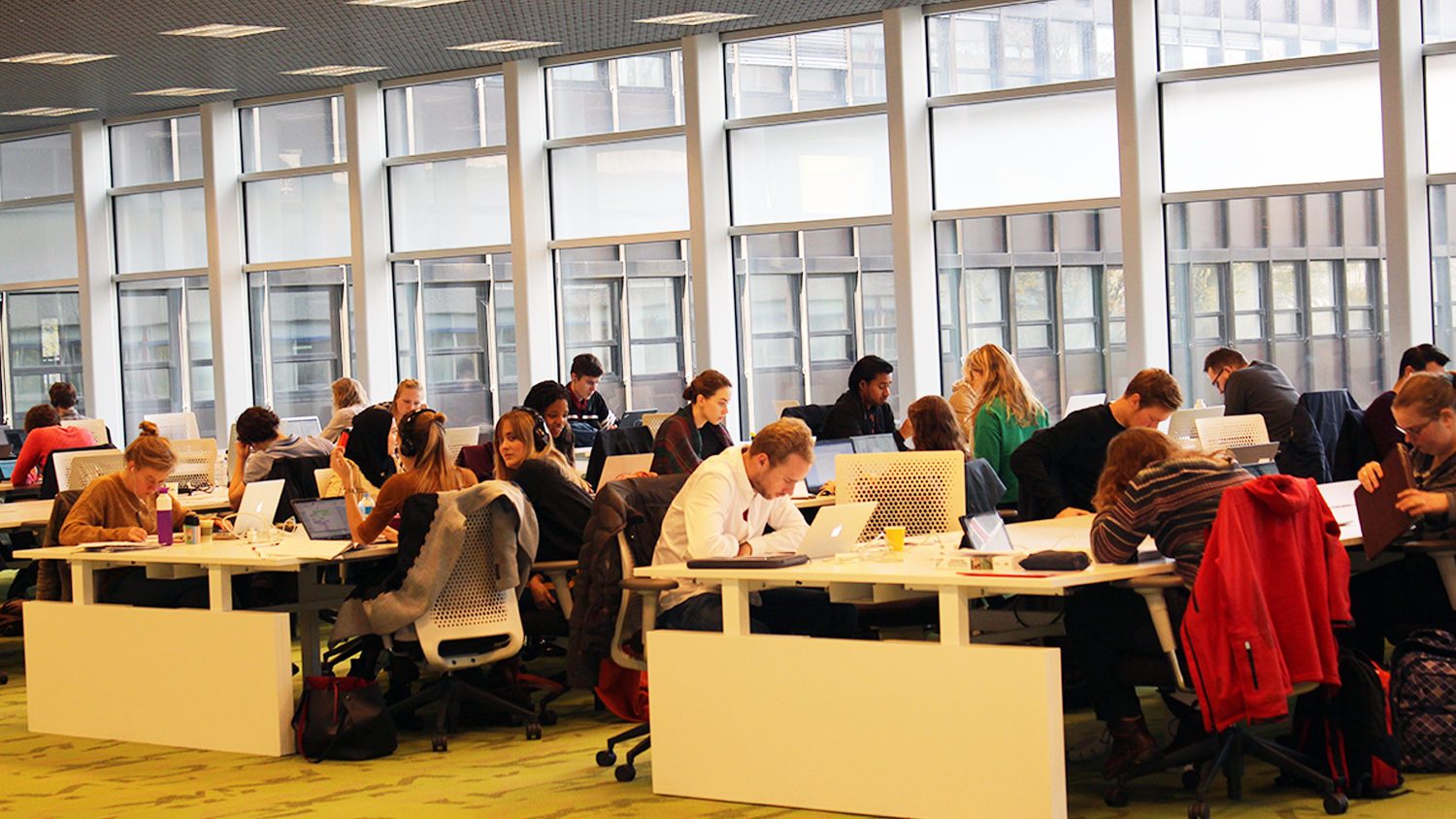What binds the Science and Geoscience Faculties?

On Wednesday, November 21, DUB on Tour will visit the Koningsberger building in De Uithof. DUB’s editors would like to meet employees and students of both the Geosciences and Sciences faculties, to hear their ideas on our coverage and what DUB should write about. In the light of this occasion, DUB buried itself in the history books of the two faculties – and concludes the current governance is an obstruction to smooth inter-faculty cooperation.
Communal educational building
When you climb the Koningsberger building’s stairs, you’ll face the enormous video wall. The wall shows news messages of both the Sciences and Geosciences faculties. No wonder – the building, which has been in use since 2016, is the home base for students of both faculties. There are student desks, work stations, lecture halls and (educational) laboratories.
Since the building’s dedication two years ago, the study associations of both faculties share a hallway in the neighbouring Buys Ballot building. It’s easy to keep in touch when you’re right next to each other. Board members of the study associations show up at each other’s office regularly, and sometimes organise parties or lectures together. This past Thursday, for example, there was a party; a joined sports tournament will take place later this month; and there’s the annual Science Symposium Utrecht, organised by study associations UAV (Earth Sciences), A-Eskwadraat (Physics and Math), UBV (Biology), and Proton (Chemistry).
The building is the central point of De Uithof’s north-west corner. Surrounding buildings house the scientists of both faculties. In the Koningsberger building, they teach classes, and run into each other more regularly. Being close together makes it easy to get in touch with each other – even if there does need to be some kind of connection in terms of subject matter.
The close proximity of the two faculties leads to intensive contact between boards. Every two months, the deans have a meeting, talking – among other things – about the coordination of education and research. The meeting also touches on the topic of cooperation in interdisciplinary education and research. Right now, they’re working on a nomination of a shared professor.
Speed date for researchers
The most obvious connection between Sciences and Geosciences can be seen in the strategic theme Pathways to Sustainability. The Geosciences faculty, as lead manager, is first point of contact, and collaborates with Sciences and the Faculty of Law, especially within the ‘hubs’ (the place where researchers and external organisations come together). Within the faculty, education and research on sustainability are housed in the Copernicus Institute for Sustainable Development.

In line with the sustainability theme, there are several ‘focus areas’ where the collaboration between the faculties takes shape. In the focus area Complex Systems, for example, in which solutions to complex systems are sought fom an interdisciplinary point of view. Research themes include climate change and big data models. Aside from a Complexity lab, where data are analysed, there’s also a group of young scientists from different disciplines, who organise workshops under the name of Young Complexity Researchers Utrecht, and provide feedback to each other’s courses and research.
Another example is the university’s sustainability hub Future Food Utrecht, of which biologist Rens Voesenek is director. “The food chain is anything but sustainable, and within this hub, we’re looking at how we could improve that in the future,” he explains. “It’s vital to use an interdisciplinary perspective when analysing this problem.” In this subject, there’s a lot of collaboration with Social Geography. “You don’t just look at how we can make food healthier, but also at how to get said food to people, and how to motivate people to choose healthier food. And also at how to fix food distribution in urban areas.”
Voesenek says that close contact among scientists is important. “It’s definitely useful to run into each other at the coffee machine, but there are may ways of getting in touch with each other. With Future Food, we once organised a speed date, in which scientists held short talks about what they’re working on. After these speeches you could walk around and find the scientists whose work appealed to you.” He’s noticed that sometimes, it may take time to understand one another’s language or way of working. “Social geography is closely related to gamma sciences, and asks different questions than researchers at the Sciences faculty do. That’s a good thing, because you’re not going to get anywhere with exclusively technical solutions. But it does take some getting used to, learning to look at problems in a different way.”

Sustainability is not the only link between the faculties. Mathematics is taught at both Sciences and Geosciences. Here, too, teachers work together, using each other’s work, and collaborating on the creation of a summer course for students who need to catch up on deficiencies before being allowed to start their studies.
Boundaries at administrative level are logistically difficult
If they have content in common, what does that mean for collaboration at administrative level? Is it an obstacle to have education and research organised per faculty?
Appy Sluijs is professor of Paleoceanography at the group Marine Palynology and Paleoceanography, part of the Faculty of Geosciences. But before 2012, that same group was part of the Sciences faculty. Along with Paleo-ecology and Natural Sciences & Society, these researchers switched faculties due to a far-reaching reorganisation at the Sciences faculty. Sluijs: “We still work with Biology a lot, as well as the Institute for Marine and Atmospheric Research Utrecht (IMAU), in both education and research.”
Sluijs does say the boundaries of the faculties can be limiting. “The negotiations for a new five-year covenant cost an enormous amount of time and effort. Issues mostly arise in education, because it needs coordination of finances at faculty level. So when Sciences teachers teach classes at Geosciences or vice versa, that means money needs to be exchanged between faculties. “Those are difficult issues, logistically,” says Sluijs.
Especially now both research and education tend to be labelled as ‘interdisciplinary’ more and more often, this means a different way of handling this seems necessary. “It’s not always easy,” admits professor Bert van der Zwaan, former dean at Geosciences and former rector magnificus of the UU. “But so far, we haven’t found any good alternatives for organising these things within the university. You do need faculties for that.”
Old discussions about merges
In the past, there have been intense discussions about possible merges of the Sciences and Geosciences faculties. The discussion was rampant at the beginning of this century. That which is now Geosciences was then two separate faculties: Earth Sciences and Spatial Sciences. Sciences consisted of five separate faculties: Physics and Astronomy, Math and IT, Biology, Chemistry, and Pharmaceutical Sciences.
“During that time, a possible merge was discussed. Should earth scientists join natural scientists or merge with the faculty of spatial sciences? Several groups within the Earth Sciences fought fierce battles in print in the Ublad. Eventually, the choice was made in 2003 to create one Faculty of Geosciences,” says Pieter Hooimeijer. As professor of social geography, he was the first dean of geosciences, along with vice dean Bert van der Zwaan, who came from the faculty of Earth Sciences.
Focused on the future
So, to what extent does the administrative division obstruct internal collaboration? Hooimeijer thinks scientists used to stick more closely to their own disciplines than the current generation. Contacts with other faculties go beyond just the collaborations of Geosciences and Sciences. Sciences has its strategic theme Life Sciences, in which it works closely with the Faculties of Medicine and Veterinary Sciences. Both Geosciences and Sciences also have close ties to Social Sciences, Law, and Humanities.

Having students and teachers close together in a single educational building has put the inter-faculty collaborations on the fast track. The new educational building mostly encourages contact between students.
Teachers of Geosciences are currently in a separate building, which means they don’t have quite as much contact with students. But the scientists are relatively close together, so it’s easy to stay in touch with each other. There are more formal and informal connections. That collaboration doesn’t mean there’s a need to have one single faculty, teachers think. There is, however, a need for a more flexible, more creative way of ensuring the boundaries between faculties don’t create obstructions for collaborations. But that’s a problem that’s true for the entire university, and not just for the Sciences and Geosciences faculties.